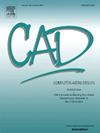使用定制形状的刀具对自由几何形状的5轴侧面数控加工进行光滑表面加工
IF 3.1
3区 计算机科学
Q2 COMPUTER SCIENCE, SOFTWARE ENGINEERING
引用次数: 0
摘要
传统上,几何建模是高效制造管道的关键部分,因为在虚拟领域中,人们可以决定使用哪些特定的制造工具以及如何移动它们。侧铣是五轴数控加工的精加工阶段,在这个阶段,加工精度与待加工工件的表面光洁度同等重要。螺旋桨或圆盘等基准加工几何形状是双曲面,通常需要刀具的多条路径才能获得高精度的表面光洁度。然而,导航工具切向移动(即以侧翼方式)到表面是非常严格的,为了获得高度精确的近似值,通常必须妥协相邻路径的平滑性。要以平滑(g1 -连续)的方式连接相邻的路径,使用圆锥工具只能用于合理平坦的目标几何形状,例如螺旋锥齿轮,然而,对于一般的自由曲面,圆锥工具不能提供足够的自由度。在这项工作中,我们考虑了通常弯曲的、自定义形状的切割工具,其形状是由所提出的基于优化的框架计算的设计参数,以使其运动全局适应输入自由曲面,支持相邻路径之间G1连接的特征。我们在合成自由曲面和工业基准数据集上演示了我们的算法,结果表明,优化工具的形状提供了更大的灵活性,可以在相邻条之间产生G1连接,并且在近似误差和平滑度方面都优于锥形工具。本文章由计算机程序翻译,如有差异,请以英文原文为准。
Smooth surface finishing for 5-axis flank CNC machining of free-form geometries using custom-shaped tools
Geometric modeling is traditionally a key part of an efficient manufacturing pipeline as one can decide, in virtual realm, what specific manufacturing tools to use and how to move them. Flank milling is the finishing stage of 5-axis Computer Numerically Controlled (CNC) machining, a stage where the machining accuracy is equally important as the smooth surface finish of the to-be-manufactured workpiece. The benchmark machining geometries such as propellers or blisks are doubly-curved surfaces and one typically needs several paths of the tool to get highly accurate surface finish. However, navigating a tool to move tangentially (i.e., in flank fashion) to the surface is very restrictive and in order to get highly accurate approximation, one typically has to compromise the smoothness across the neighboring paths.
To connect neighboring paths in smooth (-continuous) fashion using a conical tool is possible only for reasonably flat target geometries, such as spiral bevel gears, however, for a general free-form surface conical tools do not offer sufficient degrees of freedom. In this work, we consider generally curved, custom-shaped, cutting tools, whose shape is a design parameter computed by the proposed optimization-based framework to adapt their motions globally to the input free-form surface, supporting a feature of connection across the neighboring paths. We demonstrate our algorithm on synthetic free-form surfaces as well as on industrial benchmark datasets, showing that optimizing the shape of the tool offers more flexibility to produce connections between neighboring strips and outperforms conical tools both in terms of the approximation error and the smoothness.
求助全文
通过发布文献求助,成功后即可免费获取论文全文。
去求助
来源期刊

Computer-Aided Design
工程技术-计算机:软件工程
CiteScore
5.50
自引率
4.70%
发文量
117
审稿时长
4.2 months
期刊介绍:
Computer-Aided Design is a leading international journal that provides academia and industry with key papers on research and developments in the application of computers to design.
Computer-Aided Design invites papers reporting new research, as well as novel or particularly significant applications, within a wide range of topics, spanning all stages of design process from concept creation to manufacture and beyond.
 求助内容:
求助内容: 应助结果提醒方式:
应助结果提醒方式:


